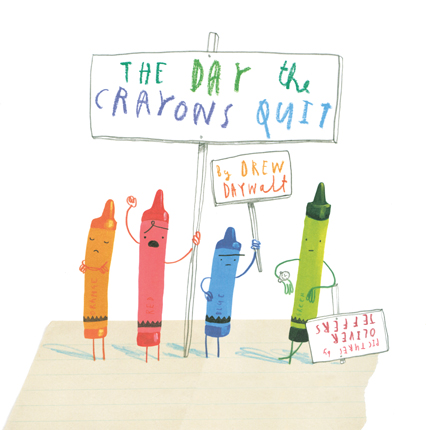| Day the crayons quit (Crayons books) Author: Daywalt, Drew | ||
| Price: $23.08 | ||
Summary:
When Duncan arrives at school one morning, he finds a stack of letters, one from each of his crayons, complaining about how he uses them.
| Illustrator: | Jeffers, Oliver |
| Accelerated Reader Information: Interest Level: LG Reading Level: 3.80 Points: .5 Quiz: 159597 | Reading Counts Information: Interest Level: K-2 Reading Level: 3.50 Points: 1.0 Quiz: 61345 | |
Reviews:
Kirkus Reviews (05/01/13)
School Library Journal (+) (07/01/13)
Booklist (07/01/13)
The Bulletin of the Center for Children's Books (+) (09/13)
The Hornbook (00/11/13)
Full Text Reviews:
School Library Journal - 07/01/2013 K-Gr 2—In this delightfully imaginative take on a beloved childhood activity, a young boy's crayons have had enough. Fed up with their workload and eager to voice their grievances, they pen letters to Duncan detailing their frustrations. Energetic and off-the-wall, the complaints are always wildly funny, from the neurotically neat Purple ("If you DON'T START COLORING INSIDE the lines soon… I'm going to COMPLETELY LOSE IT") to the underappreciated White ("If I didn't have a black outline, you wouldn't even know I was THERE!"). Daywalt has an instinctive understanding of the kind of humor that will resonate with young children, such as Orange and Yellow duking it out over which of them represents the true color of the sun or Peach's lament that ever since its wrapper has fallen off, it feels naked. Though Jeffers's messily scrawled crayon illustrations are appropriately childlike, they're also infused with a sophisticated wit that perfectly accompanies the laugh-out-loud text; for example, a letter from Beige, in which he bemoans being tasked with drawing dull items like turkey dinners, is paired with an image of the crestfallen crayon drooping over beside a blade of wheat. Later on, Pink grumbles about constantly being passed over for less-feminine colors while the opposite page depicts a discomfited-looking pink monster and cowboy being derided by a similarly hued dinosaur. This colorful title should make for an uproarious storytime and may even inspire some equally creative art projects.—Mahnaz Dar, Library Journal - Copyright 2013 Publishers Weekly, Library Journal and/or School Library Journal used with permission.
Booklist - 07/01/2013 Duncan’s crayons are on strike. One morning he opens his desk looking for them and, in their place, finds a pack of letters detailing their grievances, one crayon at a time. Red is tired. Beige is bored. Black is misunderstood. Peach is naked! The conceit is an enticing one, and although the crayons’ complaints are not entirely unique (a preponderance centers around some variation of overuse), the artist’s indelible characterization contributes significant charm. Indeed, Jeffers’ ability to communicate emotion in simple gestures, even on a skinny cylinder of wax, elevates crayon drawing to remarkable heights. First-class bookmaking, with clean design, ample trim size, and substantial paper stock, adds to the quality feel. A final spread sees all things right, as Duncan fills a page with bright, delightful imagery, addressing each of the crayons’ issues and forcing them into colorful cooperation. Kids who already attribute feelings to their playthings will never look at crayons the same way again. - Copyright 2013 Booklist.
Bulletin for the Center... - 09/01/2013 “One day in class, Duncan went to take out his crayons and found a stack of letters with his name on them.” What follows is a hilarious epistolary tale wherein each crayon, in childlike printing on lined paper, shares something with Duncan. Some feel overworked (“Gray crayon here. You’re KILLING ME! I know you love Elephants. And I know that elephants are gray . . . but that’s a LOT of space to color in all by myself”), some feel underappreciated (writes Beige Crayon, “The only things I get are turkey dinners (if I’m lucky) and wheat, and let’s be honest-when was the last time you saw a kid excited about coloring wheat?”). Some crayons are caught up in disputes (Orange Crayon and Yellow Crayon both insist they are the true color of the sun, as evidenced by pages from coloring books that Duncan completed), while others have entirely unique issues (“It’s me, peach crayon. Why did you peel off my paper wrapping?? Now I’m NAKED and too embarrassed to leave the crayon box”). Each spread includes a reproduction of the actual letter (written in crayon, of course) on the verso, facing an appropriate composition such as a childlike crayon drawing or a colored-in page from a coloring book. The crayons themselves, with deceptively simple line and dot faces, are rich in emotion and character, and it’s entertaining to consider each crayon’s representation in light of the voice in its letter. While potential lessons in inference, point of view, and persuasive writing abound in the crayons’ letters, this is guaranteed to see just as much use for being just plain fun. Move over, Click, Clack, Moo (BCCB 9/00); we’ve got a new contender for most successful picture-book strike. HM - Copyright 2013 The Board of Trustees of the University of Illinois.



